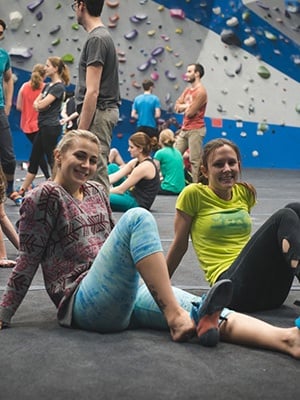The Sendy Times
Expand your climbing knowledge with training tips and tricks from Movement's instructors, trainers, and coaches.

Climbing Community | Training for Climbing | Climbing Tips
By: Movement Staff

Climbing Community | Training for Climbing | Comp Climbing | speed climbing
By: Movement Staff
Hosted at Movement Plano this past weekend, 21 of the country’s top Speed Climbers assembled for USA Climbing’s Speed Training Camp. Offering our Climbers premium lessons to aid in keeping their excellent performance this season. (photo by: Phuc Nguyen) Head Coach of the Team CRG Atlanta, Olexiy Shulga, led the wonderful climbing program. Utilizing her extensive expertise working with some of the county’s highest performing Speed Climbers. Various officials from the US Olympic & Paralympic Committee also made the journey to support our athletes, like Senior Strength & Conditioning Coach, Amanda Fleece, and Senior Psychological Services Provider, Sean McCann. (photo by: Phuc Nguyen) Beyond just tuning their skills in a more collaborative space, this camp gave the opportunity to bring together athletes from around the country to make bonds, compare programming, and share techniques. A chance some only get during competitions.

Get the latest climbing news, tips and tricks straight to your inbox.

Training for Climbing | Climbing Tips | Fitness and Yoga
By: Kat Ku
When we aim to level up our climbing, many of us tend to focus on finger strength, endurance, technique, or power. While these aspects of training are crucial to climbers, one element we often overlook is mobility. Before diving into how mobility can supercharge your climbing, let’s clarify what it really means.

Rock Climbing | Training for Climbing | Climbing Tips | bouldering
By: Kat Ku
What is a Spray Wall?

Training for Climbing | Climbing Tips
By: Movement Staff
Fear is a natural response when climbing, whether you're scaling towering walls or tackling tricky boulders. It can keep you sharp, but it can also paralyze you if left unchecked. Managing fear is key to building confidence and finding joy in climbing, and one of the most effective tools you have is your breath. Here are some breathing techniques to help you stay calm and focused during your climbs.

Climbing Community | Training for Climbing
By: Erin
Stalling out is seemingly the most normal thing that can happen to a person in climbing, but that doesn’t make it any less frustrating, and it certainly doesn’t make it easier to fix. In early 2022, I was stuck on the Dinner Ledge of plateaus and searching for a way to improve, when my friend and climbing partner let me know that Movement Sunnyvale was starting up Peak Performance Training (PPT). I decided that getting professional coaches involved was a solid plan, so I signed up.

Training for Climbing | Climbing Tips
Does this sound like you? You’ve been climbing consistently, hangboarding, and training off the wall, but you still can’t send your project. Or maybe you’re a more casual climber but you’re so sore after each session, you’re not able to climb as much as you’d like. Either way, the missing puzzle piece may be nutrition.

Training for Climbing | Climbing Tips | Fitness and Yoga
By: Movement Staff
Rock climbing is a multifaceted sport that challenges the climber's physical strength, mental acuity, and technical skills. Beyond the thrill of ascent, it’s a dance of precision where fitness and strength training play a crucial role in enhancing overall performance. Unlike conventional gym routines, climbing demands a combination of strength, technique, and problem-solving, offering a holistic approach to fitness that can transform climbing abilities. Boosting Physical Capabilities: The Role of Strength Training Incorporating strength training into a climber's regimen is pivotal for pushing past plateaus and advancing to more challenging routes. Key exercises like deadlifts and pull-ups build muscle endurance and power, which are essential for maintaining grip and pulling oneself up on the rock. Additionally, core-focused workouts such as planks and leg raises develop the stability needed to balance and maneuver through complex sequences on the wall. Grip Strength: The Foundation of Climbing One of the most direct benefits of weightlifting for climbers is the enhancement of grip strength. Exercises that involve hand weights, barbells, or resistance bands can significantly improve a climber’s ability to hold onto grips with less fatigue. This is crucial for both bouldering and big wall climbing where a strong, enduring grip can make the difference between success and a fall. Enhancing Flexibility and Mobility While strength is a clear asset, flexibility and mobility are equally critical. Climbers also benefit from incorporating yoga into their training schedules to increase their range of motion. This flexibility allows climbers to reach farther holds and maintain more challenging positions without injury. Dynamic stretching can also aid in preventing strains and enhances the fluidity of movements on the rock. Building a Community of Strength and Skill Strength training for climbers often thrives in a community setting, where shared goals foster motivation and learning. Climbing gyms (like Movement!) that offer fitness classes tailored to climbers provide environments where novices and veterans alike can learn from each other’s experiences and push their limits under the guidance of trainers familiar with the unique demands of the sport. The Synergy of Climbing and Strength Training The integration of strength training and climbing is not merely about achieving physical improvements; it enriches the climbing experience, boosting confidence and enabling climbers to tackle more difficult projects. This synergy not only elevates individual performance but also contributes to a richer, more inclusive climbing culture, where climbers support one another in achieving their personal bests. By emphasizing both fitness and climbing, climbers can enjoy a more fulfilling experience in the sport—advancing their skills, overcoming challenges, and enjoying the community that comes with shared pursuit of climbing excellence.

By: Jack Skelton
If you spend any time climbing or hang boarding, you can benefit from some additional wrist and finger exercises to help build strong, durable joints. Doing so allows us to practice our favorite sport pain-free and hopefully prevent future injuries. Here are a few great exercises you can do at home or before your climbing sessions.

Training for Climbing | Climbing Tips
By: Ezra Park
here's how to overcome the overhang mental game When it comes to climbing terrain, few things seem to inspire as much fear and intimidation as the overhang wall. So if you find yourself quickly walking past the Gnarwall at Rockville, Megaprow at Dallas the Hill, the Constant Wall in Sunnyvale, or the Iceberg in Portland to climb more vertical terrain or you’ve ever questioned whether you have enough upper body strength climb through steep terrain (you probably have more than you think), keep reading! One of our awesome climbing coaches, Ezra Park, has some great advice for ya.